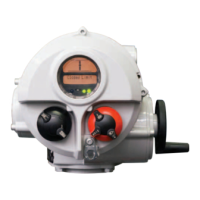
Do you have a question about the rotork IQT and is the answer not in the manual?
| Quarter-turn | Yes |
|---|---|
| Housing Material | Aluminum alloy |
| Torque Range | 10 Nm to 3000 Nm |
| Multi-turn | Yes |
| Linear | Yes |
| Ingress Protection | IP68 |
| Communication Protocols | Modbus, Profibus, Foundation Fieldbus |
| Operating Temperature | +70°C |
| Local Controls | local pushbuttons |
| Control Modes | Modulating |
| Display | LCD |
| Type | Intelligent Electric Actuator |
Learn to operate the actuator manually using the handwheel.
Steps to operate the actuator using electrical power.
Understand actuator display indications for status, travel, control, and alarms.
Procedures for preparing drive bushes for specific base types.
Guide on machining and fitting the drive bush for proper valve stem engagement.
Safe procedures for lifting and handling the actuator.
Steps to properly mount and secure the actuator to the valve.
Adjustment and setting of actuator stop bolts for travel limits.
Steps for safely removing the terminal cover for access.
Instructions for making electrical connections to actuator terminals.
Overview of the actuator setting procedure using the Setting Tool.
Details and operation of the new Rotork Setting Tool Pro.
Steps to enter the actuator setting mode.
Procedures for setting and managing the actuator password.
How to check actuator settings without altering them.
How to configure settings with the main power supply turned off.
Guide to navigating and accessing configuration options.
Setting how the actuator responds to control modes and interlocks.
Selecting the type of remote control input.
Restoring factory or customer default settings.
Setting the actuator model and speed range.
Overview of the IQT battery failsafe actuator function.
Steps to commission the battery failsafe system.
Configuration of failsafe actions based on AC supply loss.
Using the Setting Tool Pro to download/upload data and configurations.
Accessing diagnostic help screens for troubleshooting.
Advice on product disposal and environmental considerations.
Setting the start and end limits for partial stroke testing.
Defining the set point position for partial stroke tests.
Setting timeout for partial stroke completion and alarms.